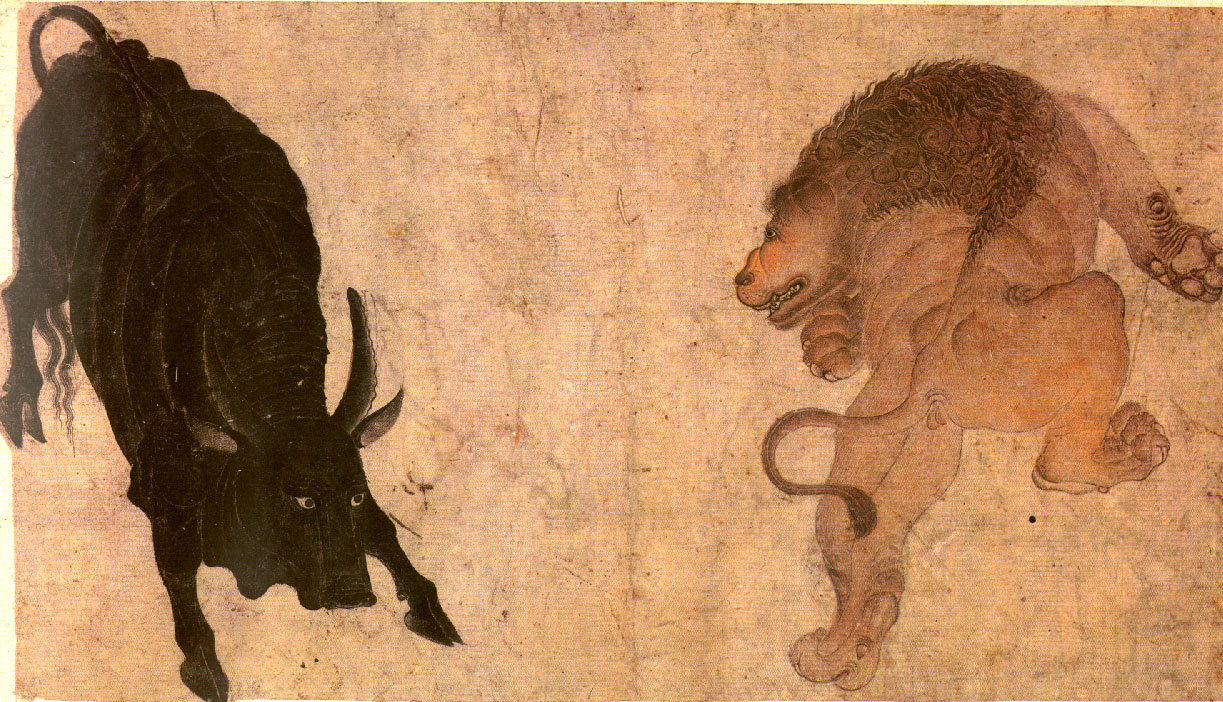The Bulls And The Lion on:
[Wikipedia]
[Google]
[Amazon]
 The bulls and the lion is counted as one of
The bulls and the lion is counted as one of
pp.659-70
/ref>
 The bulls and the lion is counted as one of
The bulls and the lion is counted as one of Aesop's Fables
Aesop's Fables, or the Aesopica, is a collection of fables credited to Aesop, a slave and storyteller believed to have lived in ancient Greece between 620 and 564 BCE. Of diverse origins, the stories associated with his name have descended to ...
and is numbered 372 in the Perry Index
The Perry Index is a widely used index of "Aesop's Fables" or "Aesopica", the fables credited to Aesop, the storyteller who lived in ancient Greece between 620 and 560 BC. The index was created by Ben Edwin Perry, a professor of classics at the Un ...
. Originally it illustrated the theme of friendship, which was later extended to cover political relations as well.
The fable
A lion keeps watch on a field in which two, three or four bulls are grazing. Knowing that they will group together to defend each other, the lion sows enmity between them so that they separate and he is able to kill them one by one. Early versions of the fable are in Greek, beginning withBabrius
Babrius ( grc-gre, Βάβριος, ''Bábrios''; century),"Babrius" in ''Chambers's Encyclopædia''. London: George Newnes, 1961, Vol. 2, p. 21. also known as Babrias () or Gabrias (), was the author of a collection of Greek fables, many of whic ...
, and there is a later latinised version by Avianus
Avianus (or possibly Avienus;Alan Cameron, "Avienus or Avienius?", ''ZPE'' 108 (1995), p. 260 c. AD 400) a Latin writer of fables,"Avianus" in ''Chambers's Encyclopædia''. London: George Newnes, 1961, Vol. 2, p. 5. identified as a pagan.
The ...
. In the 4th century CE the rhetorician Themistius
Themistius ( grc-gre, Θεμίστιος ; 317 – c. 388 AD), nicknamed Euphrades, (eloquent), was a statesman, rhetorician, and philosopher. He flourished in the reigns of Constantius II, Julian, Jovian, Valens, Gratian, and Theodosius I; ...
introduced a variant in which it is a fox that brings discord so that the lion can profit from it.
The moral given the story was generally to distrust a foe and hold fast to friends, but in the Syntipas
Syntipas ( el, Συντίπας) is the Greek form of a name also rendered Sindibad ( ar, سندباد), Sandbad ( fa, سندباد), Sendabar ( he, סנדבר), Çendubete (Spanish) and Siddhapati ( sa, सिद्धपति) in other versions ...
version it was later given a political turn: “This fable shows that the same is true of cities and people: when they are in agreement with one another, they do not allow their enemies to defeat them, but if they refuse to cooperate, it is an easy matter for their enemies to destroy them.” A similar sentiment was taken up in the collection illustrated by the English artist Francis Barlow in 1665, where the story is applied to state alliances. The lesson of holding fast to an alliance against the common foe was later repeated in a poem often reprinted during the American War of Independence, where there are 13 bulls in the field, the number of states in revolt.
A much longer poem, praising friendship and describing how the fox brings division among the bulls through lies and flattery, accompanied the fable of "The Four Bulls" in Thomas Bewick
Thomas Bewick (c. 11 August 17538 November 1828) was an English wood-engraver and natural history author. Early in his career he took on all kinds of work such as engraving cutlery, making the wood blocks for advertisements, and illustrating ch ...
’s illustrated edition of 1818. The poem had been taken from the series written by John Hawkesworth under the pseudonym H. Greville in ''The Gentleman's Magazine
''The Gentleman's Magazine'' was a monthly magazine founded in London, England, by Edward Cave in January 1731. It ran uninterrupted for almost 200 years, until 1922. It was the first to use the term '' magazine'' (from the French ''magazine ...
'' in 1741. There the fable had been incorporated as one element in a didactic poem titled "The Whisperer".''The Gentleman’s Magazine'', vol.XI (1741)pp.659-70
/ref>
References
External linksBook illustrations
from the 17th-20th century
{{DEFAULTSORT:Bulls and the Lion, The
Aesop's Fables